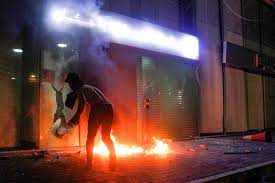Lebanon’s Consumer Price Index in October surged 158.5%, with the cost of healthcare jumping nearly fourfold
Hyperinflation in Lebanon continued for the 28th consecutive month in October, with the Central Administration of Statistics’ Consumer Price Index increasing by 186.4 per cent in the first 10 months of 2022 from the same period a year earlier.
Inflation rose to about 158.5 per cent in October from the same month a year earlier. The CPI increased about 14.6 per cent from September 2022.
The country is in the grip of an economic crisis described by the World Bank as one of the worst in modern history and has yet to implement critical structural and financial reforms required to unlock $3 billion of assistance from the International Monetary Fund.
Reforms hinge on the formation of a new government, the election of a new president and consensus among the country’s political elite.
Lebanese politicians are deadlocked over the formation of a new Cabinet six months after parliamentary elections and six-year term of former president Michel Aoun expired at the end of October.
Political impasses have previously led to political vacuums in the country and stalled its economic progress. Lebanon was without a president for two and a half years until Mr Aoun’s election by the 128-seat Parliament in 2016. His predecessor, Michel Sleiman, was elected in 2008 after the position had been vacant for 18 months.
Securing IMF backing will help to unlock a further $11 billion of assistance that was pledged at a Paris donor conference in 2018, which is also tied to a string of reforms.
Lebanon’s economy collapsed after it defaulted on about $31 billion of eurobonds in March 2020, with its currency sinking more than 95 per cent against the dollar on the black market.
Lebanon is expected to post the second-highest inflation rate in the world this year, trailing Sudan, according to Fitch Solutions.
The cost of healthcare increased nearly fourfold in October from the same period a year earlier, followed a nearly equal increase in the price of miscellaneous goods and services.
The prices of water, electricity, gas and other fuels rose by about three and half times, communication costs increased threefold, while transportation costs and the prices of food and non-alcoholic beverages also increased by a similar level.
Rates at restaurants and hotels and the cost of education also soared about threefold, while the price of clothing and footwear, the cost of alcoholic beverages and tobacco, the prices of furnishings and household equipment and the cost of recreation and entertainment jumped about two and half times.
Last month, the World Bank said the Lebanese pound’s continued sharp depreciation continues to exacerbate inflationary pressures, while the country’s financial sector is too big to be bailed out with its financial losses exceeding $72 billion, the equivalent of more than three times its gross domestic product in 2021.
In an interview with Al Hurra television last month, Central Bank Governor Riad Salameh said the exchange rate would change as of next February. The authority plans to devalue the pound officially to 15,000 to the US dollar, with the aim of unifying the country’s multiple exchange rates and abandon the 25-year peg of 1,507 pounds to the greenback.
The World Bank projects Lebanon’s real GDP will contract 5.4 per cent in 2022, assuming continued “political paralysis” and no implementation of an economic recovery strategy, it said.
This year’s contraction follows the economy shrinking about 58 per cent between 2019 and 2021 — the largest among 193 countries, the Washington-based lender said in a report in January 2022.
The IMF reform programme for Lebanon is based on five key points:
- Restructuring the financial sector to restore banks’ viability and their ability to efficiently allocate resources to support the recovery;
- Implementing fiscal reforms that, coupled with the proposed restructuring of external public debt, will ensure debt sustainability and create space to invest in social spending, reconstruction and infrastructure;
- Reforming state-owned enterprises, particularly in the energy sector, to provide quality services without draining public resources;
- Strengthening governance, anti-corruption, and anti-money laundering/combatting the financing of terrorism (AML/CFT) frameworks to enhance transparency and accountability, including by modernising the central bank legal framework and governance and accountability arrangements;
- Establishing a credible and transparent monetary and exchange rate system.
The National AE

Leave a Reply
You must be logged in to post a comment.